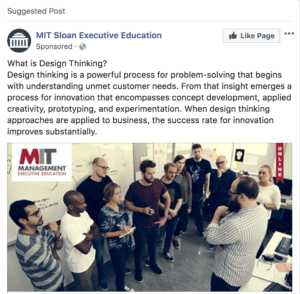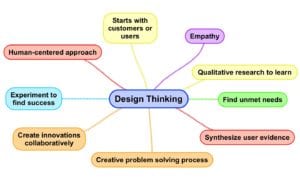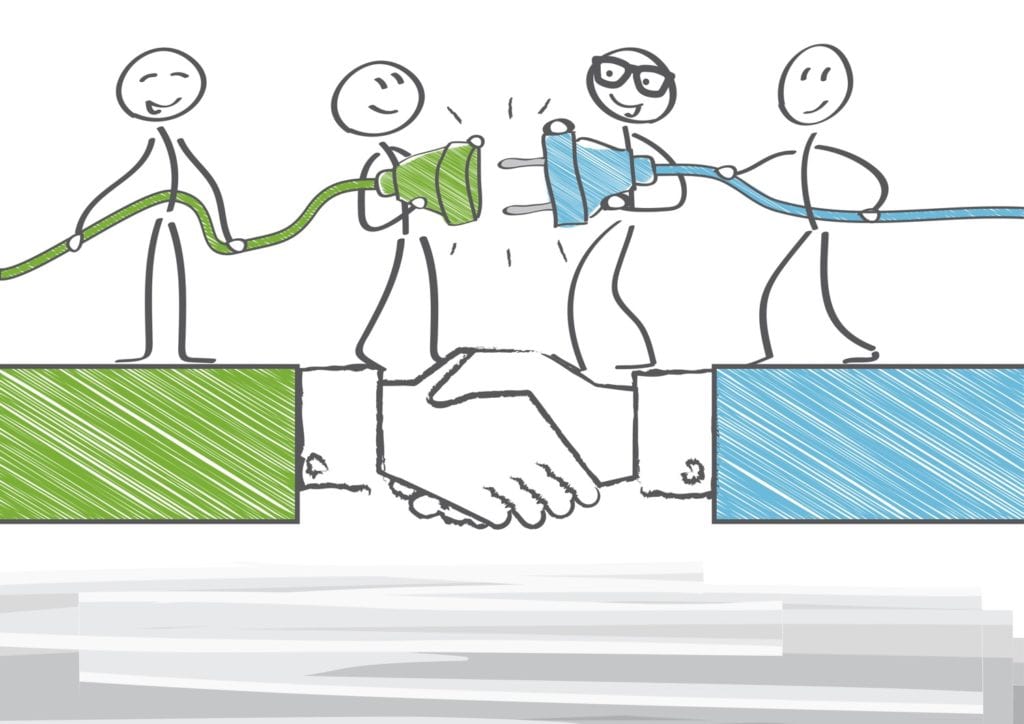Five ways to define design thinking, a popular approach to innovation
Design thinking may be one of the trends in the business world that is starting to get into your awareness and practice. But exactly how would you define design thinking, what it is and why it is needed? As business culture and the world change at an accelerating rate, organizations look for solutions to grow with their customers or users, to do new things in better ways, to improve their practices, retain and grow their customer base, and expand their business. Innovation has been a core part of this need for the future. Simply put, it’s about developing new ways to solve problems and add value…to design new products and services as well as provide customers with what they truly need. Design thinking is one of several approaches to innovation, but it can be difficult to define it. Today we are discussing what is design thinking, and providing you with several ways to think about it.
Here are a few common ways to define design thinking:
- A human-centered approach
- A problem-solving process
- An empathetic study
- An experimentation
- A hands-on collaboration
Keep reading to learn more about each of these design thinking definitions.
The Human-Centered Approach
Design thinking is a “human-centered approach to innovation that puts the observation and discovery of often highly nuanced, even tacit, human needs right at the forefront of the innovation process.” (Managing By Design)
In other words, it’s a process that’s all about the customer or user experience. It’s about knowing what humans want and need in the moment. IDEO is famous for their human centered design approach and design thinking resources. By taking a human-centered approach, designers and innovators can create solution that are effective, efficient, and enjoyable for the users.
A Problem-Solving Process
 Sometimes we learn from social media posts. This Facebook ad from MIT Sloan Executive Education defines design thinking as a “powerful process for problem-solving that begins with understanding unmet customer needs. From that insight emerges a process for innovation that encompasses concept development, applied creativity, prototyping, and experimentation.”
Sometimes we learn from social media posts. This Facebook ad from MIT Sloan Executive Education defines design thinking as a “powerful process for problem-solving that begins with understanding unmet customer needs. From that insight emerges a process for innovation that encompasses concept development, applied creativity, prototyping, and experimentation.”
At the root of it, design thinking is about solving a customer’s problem with a solution (typically product or service) that gives them what they need. It requires creativity, idea development, and experimentation. The solution may not be obvious, and it may take trial and error to find the right answer.
An Empathetic Study
According to Tim Brown and IDEO, one of the leading global innovation design companies, design thinking is about an empathetic study of data and research. Design thinking “utilizes elements from the designer’s toolkit like empathy and experimentation to arrive at innovative solutions.” You must make decisions based on solid evidence, rather than “historical data or making risky bets based on instinct.”
Empathy is a key component of design thinking, as it helps the innovators better understand the needs and wants of their users. By understanding the user’s emotional and mental state, designers can create experiences that are personalized and tailored to the user’s needs.
An experimentation
According to the Stanford d school, design thinking is “a methodology for creative problem solving” that involves heavy experimentation. You need to test your hypothesis and see your ideas in action in order to come to the right solution. By experimenting, you can gain crucial insights into how people interact with the product or service and use those insights to refine and rebuilt the design. Experimentation doesn’t have to be expensive or complicated – simple sketches or prototypes can be used to illustrate the use of the potential solution and get real feedback about its usefulness. Because of this, experimentation is a critical part of the design thinking process.
Discover how to use AI to build rapid prototypes on our blog.
A hands-on collaboration
The final way to define design thinking on this list is as a hands-on collaboration. In order to innovate successfully, you need to have successful and meaningful collaboration throughout your organization and with your customers and users. Your team needs to share insights and ideas freely and be a part of the process from start to finish.
 Now that we’ve explored these five ways to look at or define design thinking, spend some time thinking about what it means to you. Some of the key attributes associated with innovation and design thinking – user experience, collaboration, and experimentation – can really expand your impact when done intentionally. Consider creating your own mind map to explore your thoughts on the design thinking process, and what design thinking means to you.
Now that we’ve explored these five ways to look at or define design thinking, spend some time thinking about what it means to you. Some of the key attributes associated with innovation and design thinking – user experience, collaboration, and experimentation – can really expand your impact when done intentionally. Consider creating your own mind map to explore your thoughts on the design thinking process, and what design thinking means to you.
Design Thinking Research Understanding
In reviewing the research about what design thinking is, there is no clear consensus as to the language of it. In 2015, the Hasso-Plattner-Institute (HPI) and the Stanford Design Thinking Research Program conducted one of the most extensive global studies looking into different topics on the current state of Design Thinking practice in organizations. They reported this:
“The researchers could not identify a common understanding of Design Thinking. People apply various interpretations as a result of their Design Thinking training. The diversity of opinions influences practice, i.e., how Design Thinking is interpreted in firms. The different entry points to a company and the diverse applications of Design Thinking could explain this observation. 31% of survey respondents used a different terminology for Design Thinking.”
Their 2022 update of the study shared this in the report Design Thinking: a Global Study on Implementation Practices in Organizations. “Compared to 2015, 22% of participants of the 2021 study used other terms to describe the concept of Design Thinking. Companies customize the term to their specific goals to reach a larger audience of potential adopters. Some employees are averse to the term ‘Design Thinking,’ their businesses preferring the following terms: Human-Centered Design (16%) and User-Centered Design (10%).
So, if you aren’t exactly clear on how to define or describe design thinking, you are not alone.
For more helpful tools and tricks, check out our design thinking and innovation resources blog. You can also find our Starting with Design Thinking online training course for more assistance in your efforts.
Find out more about our design thinking training or innovation workshops which can be done for teams and organizations, or contact us to discuss a custom workshop or event.
Looking for more resources and guides? Review these other relevant articles on our blog.
- Frequently Asked Questions about Design Thinking
- Innovative Innovation Meetings: Formats, Designs, and Examples
- Design Thinking Workshop Exercises, Activities, and Frameworks
- Innovation Teams within Organizations
How would you define or describe what design thinking is? Share what it means to you in the comments.
